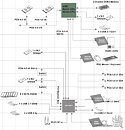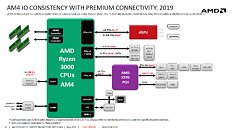- Joined
- Oct 9, 2007
- Messages
- 47,655 (7.44/day)
- Location
- Dublin, Ireland
| System Name | RBMK-1000 |
|---|---|
| Processor | AMD Ryzen 7 5700G |
| Motherboard | Gigabyte B550 AORUS Elite V2 |
| Cooling | DeepCool Gammax L240 V2 |
| Memory | 2x 16GB DDR4-3200 |
| Video Card(s) | Galax RTX 4070 Ti EX |
| Storage | Samsung 990 1TB |
| Display(s) | BenQ 1440p 60 Hz 27-inch |
| Case | Corsair Carbide 100R |
| Audio Device(s) | ASUS SupremeFX S1220A |
| Power Supply | Cooler Master MWE Gold 650W |
| Mouse | ASUS ROG Strix Impact |
| Keyboard | Gamdias Hermes E2 |
| Software | Windows 11 Pro |
AMD X570 is the company's first in-house design socket AM4 motherboard chipset, with the X370 and X470 chipsets being originally designed by ASMedia. With the X570, AMD hopes to leverage new PCI-Express gen 4.0 connectivity of its Ryzen 3000 Zen2 "Matisse" processors. The desktop platform that combines a Ryzen 3000 series processor with X570 chipset is codenamed "Valhalla." A rough platform diagram like what you'd find in motherboard manuals surfaced on ChipHell, confirming several features. To maintain pin-compatibility with older generations of Ryzen processors, Ryzen 3000 has the same exact connectivity from the SoC except two key differences.
On the AM4 "Valhalla" platform, the SoC puts out a total of 28 PCI-Express gen 4.0 lanes. 16 of these are allocated to PEG (PCI-Express graphics), configurable through external switches and redrivers either as single x16, or two x8 slots. Besides 16 PEG lanes, 4 lanes are allocated to one M.2 NVMe slot. The remaining 4 lanes serve as the chipset bus. With X570 being rumored to support gen 4.0 at least upstream, the chipset bus bandwidth is expected to double to 64 Gbps. Since it's an SoC, the socket is also wired to LPCIO (SuperIO controller). The processor's integrated southbridge puts out two SATA 6 Gbps ports, one of which is switchable to the first M.2 slot; and four 5 Gbps USB 3.x ports. It also has an "Azalia" HD audio bus, so the motherboard's audio solution is directly wired to the SoC. Things get very interesting with the connectivity put out by the X570 chipset.


Update May 21st: There is also information on the X570 chipset's TDP.
Update May 23rd: HKEPC posted what looks like an official AMD slide with a nicer-looking platform map. It confirms that AMD is going full-tilt with PCIe gen 4, both as chipset bus, and as downstream PCIe connectivity.
AMD X570 overcomes the greatest shortcoming of the previous-generation X470 "Promontory" chipset - downstream PCIe connectivity. The X570 chipset appears to put out 16 downstream PCI-Express gen 4.0 lanes. Two of these are allocated to two M.2 slots with x4 wiring, each, and the rest as x1 links. From these links, three are put out as x1 slots, one lane drives an ASMedia ASM1143 controller (takes in one gen 3.0 x1 and puts out two 10 Gbps USB 3.x gen 2 ports); one lane driving the board's onboard 1 GbE controller (choices include Killer E2500 or Intel i211-AT or even Realtek 2.5G); and one lane towards an 802.11ax WLAN card such as the Intel "Cyclone Peak." Other southbridge connectivity includes a 6-port SATA 6 Gbps RAID controller, four 5 Gbps USB 3.x gen 1 ports, and four USB 2.0/1.1 ports.
Update May 21st: The source also mentions the TDP of the AMD X570 chipset to be at least 15 Watts, a 3-fold increase over the X470 with its 5W TDP. This explains why every X570-based motherboard picture leak we've seen thus far shows a fan-heatsink over the chipset.
View at TechPowerUp Main Site
On the AM4 "Valhalla" platform, the SoC puts out a total of 28 PCI-Express gen 4.0 lanes. 16 of these are allocated to PEG (PCI-Express graphics), configurable through external switches and redrivers either as single x16, or two x8 slots. Besides 16 PEG lanes, 4 lanes are allocated to one M.2 NVMe slot. The remaining 4 lanes serve as the chipset bus. With X570 being rumored to support gen 4.0 at least upstream, the chipset bus bandwidth is expected to double to 64 Gbps. Since it's an SoC, the socket is also wired to LPCIO (SuperIO controller). The processor's integrated southbridge puts out two SATA 6 Gbps ports, one of which is switchable to the first M.2 slot; and four 5 Gbps USB 3.x ports. It also has an "Azalia" HD audio bus, so the motherboard's audio solution is directly wired to the SoC. Things get very interesting with the connectivity put out by the X570 chipset.


Update May 21st: There is also information on the X570 chipset's TDP.
Update May 23rd: HKEPC posted what looks like an official AMD slide with a nicer-looking platform map. It confirms that AMD is going full-tilt with PCIe gen 4, both as chipset bus, and as downstream PCIe connectivity.
AMD X570 overcomes the greatest shortcoming of the previous-generation X470 "Promontory" chipset - downstream PCIe connectivity. The X570 chipset appears to put out 16 downstream PCI-Express gen 4.0 lanes. Two of these are allocated to two M.2 slots with x4 wiring, each, and the rest as x1 links. From these links, three are put out as x1 slots, one lane drives an ASMedia ASM1143 controller (takes in one gen 3.0 x1 and puts out two 10 Gbps USB 3.x gen 2 ports); one lane driving the board's onboard 1 GbE controller (choices include Killer E2500 or Intel i211-AT or even Realtek 2.5G); and one lane towards an 802.11ax WLAN card such as the Intel "Cyclone Peak." Other southbridge connectivity includes a 6-port SATA 6 Gbps RAID controller, four 5 Gbps USB 3.x gen 1 ports, and four USB 2.0/1.1 ports.
Update May 21st: The source also mentions the TDP of the AMD X570 chipset to be at least 15 Watts, a 3-fold increase over the X470 with its 5W TDP. This explains why every X570-based motherboard picture leak we've seen thus far shows a fan-heatsink over the chipset.
View at TechPowerUp Main Site






